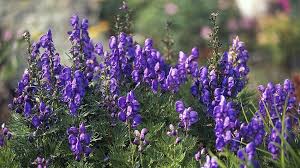
Aconitum napellus
Latin name: Aconitum napellus
Short name: Acon.
Common name: Monkshood | Aconite | Wolfsbane | Blue rocket | Friar's cap
Primary miasm: Acute
Kingdom: Plants
Family: Ranunculaceae (Buttercup family)
- Symptomatology
- Remedy Information
- Differentiation & Application
Aconitum napellus is a tall, flowering plant known for its striking blue to purple hood-shaped blossoms. It is one of the most poisonous plants in Europe, containing the alkaloid aconitine, which affects the nervous system and heart. Even minimal exposure to the raw plant—especially the root—can be fatal.
Historically, Aconite was used in traditional medicine to treat fevers and pain, though this fell out of favour due to its toxicity. In antiquity, it was used as a poison on spears and arrows, and in hunting wolves—hence the name “wolfsbane.” Its modern non-homeopathic use is virtually nonexistent due to its dangerous nature.
Proved by Samuel Hahnemann and published in Materia Medica Pura (early 1800s). Proving was conducted using repeated doses of the mother tincture and potentised preparations.
Nervous system (especially sensory nerves)
Circulation and heart
Lungs and pleura
Mucous membranes (upper respiratory tract)
Mind and emotions (acute fear and panic)
Open air; perspiration; rest; lying on the affected side; warmth (but not hot rooms); sitting still.
Cold, dry wind; sudden shock or fright; night (especially after midnight); warm rooms; touch; motion; suppressed perspiration; music.
- Belladonna: Also sudden, violent onset—but with more throbbing, red face, and delirium.
- Gelsemium: Gradual onset, dull, with heaviness and weakness rather than fear.
- Argentum nitricum: Anxiety and fear of death, but more anticipatory and chronic.
- Arsenicum album: Fear and restlessness, but more chronic and burning in nature.
- Phosphorus: Also fears death and storms, but more open, weepy, and impressionable.
- Complementary: Sulphur, Belladonna
- Antidotes: Camphor, Nux vomica
- Inimical: Coffea (rarely follows well)
- Follows well: Belladonna, Bryonia
- Precedes well: Sulphur, Phosphorus
Aconitum napellus is the great remedy of the threshold—the moment before disease settles, when the body is in turmoil, and the mind is seized by fear. It suits individuals with a strong, vital response to danger who are thrown into panic by sudden shocks. It is the remedy of storms—emotional, physical, and environmental. Its genius lies in the acute stage, when the system reacts violently and defensively to invasion or injury.
Ideal in the first hours of acute illness after exposure to cold wind, fright, or shock. Use in sudden high fevers, croup, pneumonia, neuralgia, and acute anxiety attacks. Excellent for post-trauma emotional states, especially following near-death experiences or witnessing accidents. In 30C or 200C, acts quickly; LM potencies useful for ongoing anxiety. Avoid overuse in chronic states.
Mind
- MIND – Fear of death, predicts the hour
- MIND – Anxiety, with palpitations
- MIND – Restlessness, intense
- MIND – Ailments from fright
Head
- HEAD – Pain, forehead, from cold wind
- HEAD – Congestion, sudden
Eyes
- EYES – Red, congested
- EYES – Photophobia, with burning
Chest
- CHEST – Oppression, fear of suffocation
- CHEST – Palpitation, violent
Generalities
- GENERALITIES – Sudden onset
- GENERALITIES – Cold wind, from exposure to
- GENERALITIES – Dryness, of mucous membranes
Samuel Hahnemann, Materia Medica Pura
James Tyler Kent, Lectures on Homoeopathic Materia Medica
William Boericke, Materia Medica
John Henry Clarke, A Dictionary of Practical Materia Medica
Constantine Hering, Guiding Symptoms of Our Materia Medica
